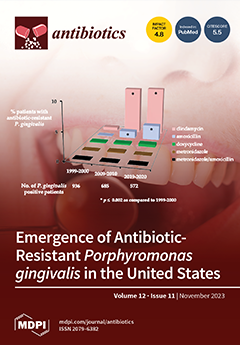This study was designed to evaluate the effects of different doses of the fibrous roots of
Polygonatum cyrtonema Hua on the growth performance, slaughter parameters, meat quality, immune function, cytokines, antioxidant capacity, and intestinal morphology of white-feathered broilers. Also, the mechanism to improve
[...] Read more.
This study was designed to evaluate the effects of different doses of the fibrous roots of
Polygonatum cyrtonema Hua on the growth performance, slaughter parameters, meat quality, immune function, cytokines, antioxidant capacity, and intestinal morphology of white-feathered broilers. Also, the mechanism to improve immune functions of broilers was explored through network pharmacology and molecular docking technology. A total of 360 AA-white-feathered broilers were randomly divided into six groups (not separated by sex), with six repetitions per group (
n = 10). The groups were as follows: basal diet (CON group), basal diet supplemented with 300 mg/kg aureomycin (ANT group), basal diet supplemented with 2%, 3%, and 4% fibrous root raw powder (LD, MD, and HD group), or basal diet supplemented with 3% fibrous root processed powder (PR group), in a 42-day experiment. The dietary inclusion of
P. cyrtonema fibrous roots increased slaughter performance (
p < 0.05), reduced the fat rate (
p < 0.05), improved intestinal morphology (
p < 0.05), and improved the immune organ index to varying degrees. It also significantly improved pH reduction, drip loss, and pressure loss of breast muscle and leg muscle (
p < 0.05). Furthermore, it significantly improved immune and antioxidant functions including decreased MDA content of serum (
p < 0.01), increased GSH-Px content (
p < 0.01), IgG, IgA, and C4 contents (
p < 0.05), and increased expression of IL-2 and IFN-γ (
p < 0.01). Additionally, the mechanism by which fibrous roots improve immune function in broilers was explored using network pharmacology and molecular docking technology. Network pharmacology and molecular docking revealed that flavonoids such as baicalein, 4′,5-Dihydroxyflavone, 5,7-dihydroxy-6,8-dimethyl-3-(4′-hydroxybenzyl)-chroman-4-one, and 5,7-dihydroxy-3-(2′-hydroxy-4′-methoxybenzyl)-6,8-dimethyl-chroman-4-one were key components that enhanced immune function through the MAPK1 and other key targets involved in regulating the MAPK signaling pathway. From the findings, it can be concluded that incorporating
P. cyrtonema Hua fibrous root as a natural feed supplement and growth promoter in broiler diets had a positive impact on bird health and performance.
Full article






